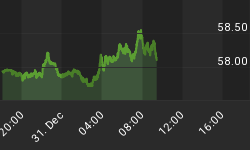Throughout last year and heading into the pivotal autumn period we continuously examined the data and saw a healthy trend emerge for the U.S. corporate outlook as bankruptcies by publicly listed companies were on the wane and the momentum, relative strength, earnings-per-share, p/e, yield, and other data suggested that the worst was over for the corporate sector and that a recovery was underway.
You may recall that this was at a time when there was a tremendous amount of bearish sentiment throughout the financial press and Internet community. You could hardly visit any financial-related website or read a newsletter without being bombarded with bearishness over the supposedly "bleak" corporate outlook. We stood virtually alone in forecasting a recovery for these companies and our outlook was rewarded as earnings and share prices took off later in the year.
But in this volatile and increasingly global financial system, things change today a lot faster than they did in years past. While many companies are sitting on still healthy levels of cash, the individual consumer is in a less enviable position than he was earlier as we enter the half-way point of the decade in this "trading range economy." What that term implies is that the fortunes of consumers (demand) and companies (supply) will shift every couple of years as the Fed is faced with the unenviable task of having to try to balance the economy from the forces of global deflation while at the same time preventing asset price inflation from getting out of hand. Net effect: a trading range in many key commodities and to some degree, the stock market.
The U.S. consumer has had his day in the sun in the earlier part of this decade and up until now. New evidence suggests that the consumer-based economy will begin struggling in the next year or two ahead as consumers deal with the excesses built up from the late '90s/early 2000s excess liquidity and consumer credit binge. It's not even possible to turn on the T.V. or radio without hearing a commercial advertising consumer debt relief services. The "get out of debt" trend has been accelerating these past couple of years and it's starting to show as consumers cut back on credit card purchases (as the latest statistics have shown). This contraction in consumer debt does not bode well for the retail sector in the 1-2 years ahead.

Speaking of retail, the latest retail sales statistic was released Feb. 15 and the number came in bearish. In fact, a mild uptrend line extending from the late 2001 period has now been violated. This suggests there are some cracks in the retail economy that are starting to grow, but so far have escaped the notice of the U.S. mainstream press (surprise, surprise!) Check out my rendition of the chart below (courtesy of BullandBearWise.com).

On the other hand, as many companies across many sectors suffered through a long phase of contraction during this same period when the consumer-based economy was being rescued by the Fed, the producer-based economy has experienced a resurgence and those old wounds should continue to heal in the year or so ahead as capital expenditures are likely to continue and the commodity price boom of the past two years helps the "old economy" producers restore depleted cash reserves.
In other words, what we are likely to begin seeing over the next several months is the reverse of the late '90s "Goldilocks" economy. "Goldilocks" was based on a strong consumer economy with exceptional strength coming from the expanding retail sector at that time and continuing into the earlier part of this decade (thanks in large part to the Fed). But it may be time for Goldilocks to give way to her less attractive counterpart, "Rusylocks." Rustylocks is far less favorable to the consumer-based economy, although she is accommodative to the producer-based economy (including to the metals-based producers as her name implies).
After bearing the brunt of the recession earlier this decade, the producers are getting a much-needed respite. The recovery in corporate profits, not to mention exports of U.S.-based companies, has rescued the producer-based economy at a time when it was desperately needed. To this end, the decline in the dollar index was a real boon to domestic producers as it increased the value of exports and helped them become more competitive in the emerging global economy. Dollar/gold manipulation will likely continue in the foreseeable future as the task of keeping the domestic economy afloat continues to be a prime objective of the Fed as the critical phase of global economic integration now underway is fully implemented.
















